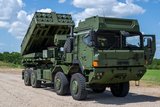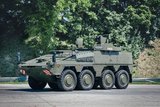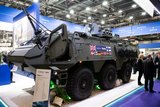European Defence Agency ploughs millions into autonomy for combat UGVs
Autonomous modules will be integrated into the existing systems, including the TheMIS, Type X, Wiesel, Lince 2 VTLM and Patria AMV. (Photo: EDA)
The European Defence Agency (EDA) has launched its largest research and technology project to develop highly autonomous combat UGVs.
The Combat Unmanned Ground Systems (CUGS) has a budget of €35.5 million ($37.99 million) and brings together nine member states and 28 industry partners.
Over 36 months, CUGS will define, design and develop a set of functional modules mounted to existing platforms. In its final stages, the project will test full demonstrators of highly autonomous combat UGVs.
The modules developed will support autonomous navigation, C2, communications, and the use of weapons systems.
These modules will be integrated into Milrem Robotics’ TheMIS, Rheinmetall’s Wiesel and larger vehicles, including Milrem’s Type X, the Iveco Lince 2 VTLM and the Patria AMV.
The five platforms will be adapted in parallel with the development of the modules.
Italy leads CUGS. Other partners include Belgium, Germany, Estonia, Finland, France, the Netherlands, Poland and Norway.
Leonardo will head up the industrial consortium. The remainder comprises John Cockerill Defence, FN Herstal and the Royal Military Academy of Belgium, Diehl Defence, KMW, MBDA and Rheinmetall of Germany, Milrem Robotics, Estonia and the Estonian Military Academy, Patria and Bittium of Finland, Nexter, Safran, Thales, MBDA and Arquus of France, TNO, Demcon and NCIM of the Netherlands, Kongsberg and FFI of Norway, and WAT, PIAP, ZMT and ASW of Poland.
UGVs can reduce the danger presented to humans, and the EDA expects systems of these kinds to play an increased role in armed forces moving forward.
More from Land Warfare
-
![Lockheed Martin to look further afield for GMARS rocket system opportunities]()
Lockheed Martin to look further afield for GMARS rocket system opportunities
The HX truck is already in use in many NATO and allied countries around the world as a logistics vehicle and carrier for high-value systems, including missile firing weapons, so its use for the Global Mobile Artillery Rocket System makes logistical sense.
-
![Beyond Survivability: How Active Protection Systems Are Empowering Commanders (Podcast)]()
Beyond Survivability: How Active Protection Systems Are Empowering Commanders (Podcast)
As threats diversify and intensify, APS are proving essential not just for vehicle protection but also for enhancing operational freedom, effectiveness and mission success in contested environments.
-
Medium knocked out of British Army LMP, with CAVS as heavyweight champion
As the British Army seeks to modernise and consolidate its diverse vehicle fleet, yet another change in direction is underway.






















